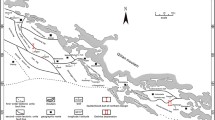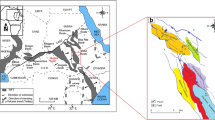Abstract
This study determined and compared, by means of total organic carbon (TOC) content analysis and Rock-Eval pyrolysis, the organic geochemistry and hydrocarbon source rock potentials of the Cenomanian–Turonian Eze-Aku (southern Benue Trough) and Campanian Nkporo Shales (Anambra Basin), southeastern Nigeria. A total of 30 samples, 15 each from both formations, were randomly collected and analyzed. The results indicate that the Eze-Aku Shale has average values of TOC (1.05 wt.%), hydrogen index, Hi, (253 mg HC/g TOC), S2 (3.2 mg HC/g), generative potential, Gp, (3.39 mg·HC/g), and pyrolysis temperature (Tmax) 436 °C that are comparatively higher than those of Nkporo Shale with TOC 0.81 wt.%, Hi 74 mg·HC/g TOC, S2 0.6 mg·HC/g, Gp 0.68 mg·HC/g, and Tmax 432 °C). Also, the average vitrinite reflectance of Eze-Aku Shale (0.67%) is higher than Nkporo Shale which is 0.59%. The organic matter is dominated by the type II and mixed type II/III kerogen for the Eze-Aku Shale and by a type III kerogen for the Nkporo Shale. The implication is that, although both formations have accumulations of marine-sourced organic matter types and would both rate as fair to good hydrocarbon source rocks (TOC > 0.50 wt.% which is considered the threshold value), the kerogen of Eze-Aku Shale is thermally more mature and is generally oil prone. Conversely, the kerogen of Nkporo Shale is within the immature to early mature stage, and is generally gas prone.










Similar content being viewed by others
References
Agagu OK, Adighije CI (1983) Tectonic and sedimentation framework of the lower Benue Trough, southeastern Nigeria. J Afr Earth Sci 1:267–274
Agagu OK, Ekweozor CM (1982) Sourcerock characteristics of Senonian shales in the Anambra syncline, southern Nigeria. J Min Geol 19:132–140
Benkhelil J (1989) The origin and evolution of the cretaceous Benue Trough (Nigeria). J Afr EarthSci 8(2–4):251–282
Bonne KPM (2014) Reconstruction of the evolution of the Niger River and implications for sediment supply to the Equatorial Atlantic margin of Africa during the Cretaceous and the Cenozoic. Geological Society, London, Special Publications, 386, 327–349. https://doi.org/10.1144/SP386.20
Bordenave ML (1993) Screening techniques for source rock evaluation – sampling and validity of results of analyses. In: Bordenave ML (ed) Applied petroleum geochemistry. Technip, Paris, pp 225–233
Burke KC (1972) Longshore drift, submarine canyons and submarine fans in development of Niger Delta. AAPG Bull 56:1975–1983
Cornford C (1986) Source rocks and hydrocarbons of the North Sea. In: Glennie KW (ed) Introduction to the petroleum geology of the North Sea, Oxford, pp 197–236
Ekweozor CM (2005) Searching for petroleum in the Anambra Basin, Nigeria. In: Okogbue CO (ed) Hydrocarbon potentials of the Anambra Basin: geology, geochemistry and geohistory perspectives. Great AP Express publishers, Nsukka, pp 83–106
Espitalié J, Deroo G, Marquis F (1985) La Pyrolyse Rock-Eval et ses applications. Première partie. Revue de l'IFP Energies nouvelles (French) – Oil Gas Sc Tech 40(5):563–579
Hunt JM (1996) Petroleum geochemistry and geology. W.H. Freeman, New York
Jarvie DM(2004) Evaluation of hydrocarbon generation and storage in Barnett shale, Fort Worth Basin Texas. The University of Texas at Austin. Bureau of Economic Geology/PTTC. 93–94
Jarvie DM (2012) Shale resource systems for oil and gas: part 1–shale-gas resource systems. In: Breyer JA (ed) Shale reservoirs–giant resources for the 21st century. AAPG Memoir, 97, pp 69–87
Ladipo KO, Nwajide CS, Akande SO (1992) Cretaceous and paleogene sequences in the Abakaliki and Anambra Basins, southern Nigeria. A field Guide International Symposium on the Geology of Deltas, PortHarcourt, p 39
Langford FF, Blanc-Valleron MM (1990) Interpreting Rock–Eval pyrolysis data using graphs of pyrolyzable hydrocarbons vs. total organic carbon. AAPG Bull 74:799–804
McCarthy K, Rojas K, Niemann, M, Palmoswski D, Peters K, Stankiewicz A (2011) Basic petroleum geochemistry for source rock evaluation. Oilfield Review Summer,Schlumberger 23(2):32–43
Murat RC (1972) Stratigraphy and paleogeography of the cretaceous and lower tertiary in southern Nigeria. In: Dessauvagie TFJ, Whiteman AJ (eds) African geology. University of Ibadan Press, Ibadan, pp 251–266
Nwajide CS (2006) Outcrop analogues as a learning facility for subsurface practitioners: the value of geological field trips. Petroleum Training J 3:58–68
Nwajide CS (2013)Geology of Nigeria’s sedimentary basins.CSS Bookshops, Lagos 565 pp
Obaje NG (2001) Petroleum systems elements across the Benue Trough and the Anambra Basin (Nigeria). An organic geochemical approach. 18thlnternational conference and exhibitions. Nigeria Association of Petroleum Explorationists, Abuja, p 87
Okoro AU, Igwe EO (2018) Lithostratigraphic characterization of the Upper Campanian–Maastrichtian succession in the Afikpo Sub-basin, southern Anambra Basin, Nigeria. J Afr Earth Sci 147:178–189
Onwe-Moses FD, Eze SO, Okoro AU, Aghamelu OP (2019) Organic geochemical evaluation and hydrocarbon prospects of the Coniacian Awgu Formation, southern Benue Trough, Nigeria. Arab J Geosci 12:77. https://doi.org/10.1007/s12517-019-4238-y
Orajaka IP, Azubuike J, Obaje N (2015) Petroleum geology for geoscientists. JB Xulon Press, Maitland
Peters KE (1986) Guidelines for evaluating petroleum source rock using programmed pyrolysis. AAPG Bull 70:318–329
Peters KE, Cassa MR (1994) Applied source rock geochemistry. In: Magoon LB, Dow WG (eds) the petroleum system–from source to trap. AAPG Mem 60:93–117
Reijers TJA (1996) Selected chapters in geology. Shell Petroleum Development Company Corporate Reprographic Series, Warri 197:59–1143
Reyment RA (1965) Aspects of geology of Nigeria. University of Ibadan Press, Ibadan, p 165
Selley RC (1998) Elements of petroleum geology, 2nd edn. Academic Press, Cambridge, p 470
Snowdon LR (1989) Organic matter properties and thermal evolution. In: Huckson I (ed) Short course no.75 on burial diagenesis. Mineralogical Association of Canada, Quebec, pp 39–60
Tissot BP, Welte DH (1978) Petroleum formation and occurrence. Springer-Verlag, New York, p 521
Unomah GI, Ekweozor CM (1993) Petroleum source rock assessment of the Campanian Nkporo Shale, Lower Benue Trough, Nigeria. NAPE Bull 8:172–186
Van Krevelen DW (1961) Coal–typology, chemistry, physics, constitution. Elsevier, Amsterdam, p 514
Whiteman AJ (1982) Nigeria: its petroleum geology, resources and potentials, vol 1. Springer, Dordrecht, p 165. https://doi.org/10.1007/978-94-009-7361-9
Acknowledgments
The authors are grateful to the staff and colleagues at the Department of Geological Sciences of the Nnamdi Azikiwe University, Awka, for criticism and technical assistance provided during this research.
Author information
Authors and Affiliations
Corresponding author
Additional information
Responsible Editor: Amjad Kallel
Rights and permissions
About this article
Cite this article
Eze, S.O., Onwe-Moses, D.F., Okoro, A.U. et al. Organic geochemical characterization of the Cenomanian–Turonian Eze-Aku (southern Benue Trough) and Campanian Nkporo Shales (Anambra Basin), southeastern Nigeria. Arab J Geosci 13, 658 (2020). https://doi.org/10.1007/s12517-020-05677-0
Received:
Accepted:
Published:
DOI: https://doi.org/10.1007/s12517-020-05677-0




